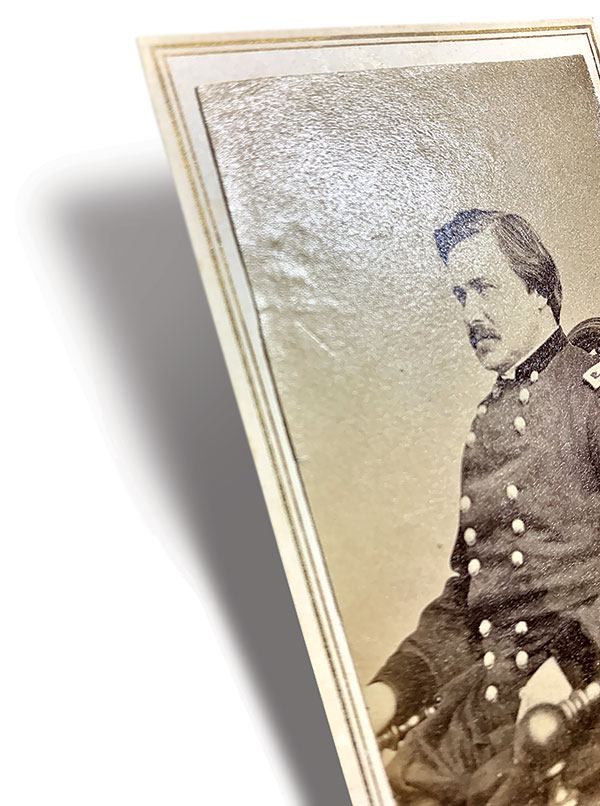This carte de visite fraud is one most collectors have likely never heard of—the remounted albumen.
Sadly, this is a fairly common practice, and one you need to learn to recognize and avoid.
By making you aware of this and what to look for, a few of my fellow dealers, and some advanced collectors, are squirming as they read these words. Why? Because it has been a practice for years in the trade and, until now, has not been exposed. This is a particularly nasty fraud because the materials involved are authentic. The mount and albumen print date to the Civil War, but are manipulated with other war date mounts and albumens to create an image that never existed until today.
Positively evil.
I will give you some tips to recognize a remount when you see one. But before I go any further, know that the promise I made early on in this column stands: I will not provide the details of how this fraud is accomplished. I won’t turn this into a “How To Guide” for any budding Dr. Evils out there.
(Note: This is the first of two columns on remounted albumens, and focuses on Union images. The next one will take on a far more prevalent criminality in my opinion—Confederate remounts.)
Location, location, location
One of the main goals of this variety of fraud is to increase the value of a photo by physically removing the albumen print from its original mount, which has no photographer’s backmark or a less desirable imprint, and attach it to another mount with a more desirable location. This move increases the profit level for both the dealer or the advanced collector involved this process. Political figures, well-known military men and other celebrities are all targets.
Rules of engagement
As a rule, remounted Union CDVs, which I will discuss first, are unidentified officers and enlisted men. Also, the fakers target certain states that command higher prices in the marketplace. These states have remained strong sellers over the three decades that I have been a full-time dealer and are always in demand. Obviously I can’t tell you which ones, but I will tell you in my experience that it is far easier and more profitable to sell an unidentified full standing armed soldier with a Michigan backmark than an image with similar content from Illinois, or with no backmark at all.
I think you get the picture—and the motivation.
It is relatively easy to find Michigan civilian images, remove the albumens and remount the soldier from a different state. If they have done a good job you won’t notice it’s a remount.
How to tell a remount
Please look closely and learn.
Every fraud has its tell. The remounting done in this image of the Sedgwick Monument is so well done it may go unnoticed, even to the most astute observer. Look very closely at the bottom of the albumen in the center of the carte. See how clean and bright the mount is, all the way down to the inside stripe? Now, look at the light tan color that begins at the same inside stripe to the outside edge of the mount, all the way around the carte. You have to really pay attention. The color change while in a plastic sleeve is understated compared to when the image is out and in clear light (as shown here).


Note: When the original print is removed, the mount surface below will be clean and bright because it has not seen the light of day in more than 150 years. The remount print will not cover exactly the same area. So look for pristine places on the mount near the edge of the print.
Photographers took great pride in their work back then, so if you can see any lumps, bumps, creases or the albumen edge crossing over the stripes at the edges of the mount and other imperfections, those are also tell-tale signs of a remount, and you should have a much closer look. This carte of Maj. Gen. Alexander M. McCook shows evidence of tampering.
This example of Maj. Gen. Franz Sigel reveals the actual indentation line from where the old albumen came off the mount. The remounted albumen of Sigel isn’t long enough to cover where the old albumen was removed. A pencil identification was used to try to obscure this line somewhat, failing as you can see. If you see an indentation of this type where the albumen should usually cover a carte, examine it closely. It is probably a remount. On a side note, one of my regular customers purchased this image online many years ago for $125.00. He displayed it proudly in his collection until recently, when he passed away.

Perry Frohne is the owner of Frohne’s Historic Military. He has been investigating fake images for more than 20 years. He is an MI Senior Editor.
SPREAD THE WORD: We encourage you to share this story on social media and elsewhere to educate and raise awareness. If you wish to use any image on this page for another purpose, please request permission.
LEARN MORE about Military Images, America’s only magazine dedicated to showcasing, interpreting and preserving Civil War portrait photography.
VISIT OUR STORE to subscribe, renew a subscription, and more.

